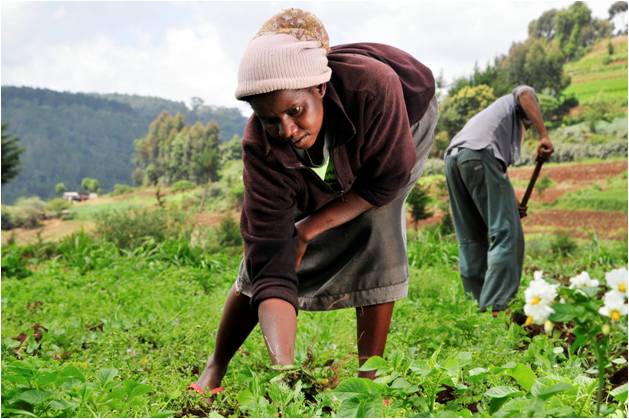Land husbandry & climate smart agriculture
Farmers generate 90 % of the economic activity in rural areas producing food and fuel to improve livelihoods and are key to national food security. Together the farmers manage over 80% of the lands under forest and agriculture in the catchment and biggest water users. Farmers are the manager of the catchment on the ground and custodians of the natural ecosystems.
Restoring the soil and improve productivity of the agricultural land is the overall goal of land husbandry. Investing in land husbandry increases resilience to climate change, reduces water erosion and soil loss, halts land degradation, and increases land productivity. Land management techniques include soil bunds, terraces, cut-off drains land husbandry practices for both rain-fed and irrigated agriculture for higher crop production.
Rwanda’s climate change vulnerability originates in the mountainous character of the country with an inherent susceptibility to soil erosion, combined with a strong reliance on rain-fed agriculture representing 34% of Rwanda’s GDP (2014) and employing 90% of its inhabitants (both directly and indirectly). This leaves the country in a challenging position with regard to climate change adaptation. As the temperature increases, Rwanda’s historically predictable rainy seasons are becoming increasingly unreliable and short, resulting in more frequent droughts and higher intensity rains with the potential of causing progressively significant economic damage to crop yields and infrastructure.
Climate smart agriculture
Climate smart agriculture (CSA) is an integrative approach to address these interlinked challenges of food security and climate change that explicitly aims for three objectives:
A: Sustainably increasing agricultural productivity, to support equitable increases in farm incomes, food security and development.
B. Adapting and building resilience of agricultural and food security systems to climate change at multiple levels; and
C.Reducing greenhouse gas emissions from agriculture (including crops, livestock and fisheries).
Climate smart agriculture approaches are mainly covered under the term ‘conservation agriculture’ (CA). This approach to agricultural management is based on three principles: Minimum soil disturbance, ranging from zero tillage to a maximum of 20 to 25%; retention of crop residues or other surface cover; and use of crop rotations to reduce the build-up of weeds, pests, and diseases. The first two principles require a drastic adaptation of the current, traditional farming methods. For the third principle, as farmers in Rwanda often do not have enough land to rotate crops, intercropping is an option.

Climate Smart Agriculture practices bring important benefits for a productive, food secure and resilient agriculture while restoring the ecosystem services and biodiversity that are essential for sustainable agriculture. Climate Smart Agriculture is based on principles of agroecology that optimizes interactions between plants, animals, humans and the environment while taking into consideration the social aspects that need to be addressed for a sustainable and fair food system. Diverse cropping patterns, and crop rotation are used to improve the soil and control of pests. Climate Smart tools include forestry, fishery, aquaculture, livestock and other areas.
The benefits of this approach with regards to climate resilience are:
- stable yields: Increased average yields in the long term due to the water and soil conserving effects of CA, which help to stabilize the crops against weather extremes;
- drought buffering: The approach increases soil water content through increased infiltration and a reduction of runoff and evaporation. Increased infiltration improves water use efficiency and buffers crops against drought;
- reduced field preparation costs: CA allows for timelier planting that supports successful harvest due to the reduction in effort associated with tillage;
- reduced soil erosion: Reducing tillage and maintaining soil cover with crop residues can reduce erosion by up to 80%. CA also generally increases soil organic matter in the top soil, along with an increase in soil biological activity and biodiversity;
- climate change mitigation: Under certain conditions, CA may contribute to climate change mitigation through carbon sequestration and reduced Green House Gas (GHG) emissions.
Farmer Field Schools are the basic organizational units where farmers learn from each other new practices to be more productive and be more resilient in the face of climatologic challenges.
FURTHER READING:
FAO Farmer Field School platform
FAO Farmer Field School Manual FFS 2016
FAO Interactions in agroecology
FAO CSA source book 2013 Climate smart agriculture
World Bank 2015 Climate smart agriculture handbook
W4GR Climate resilient interventions
W4GR Climate Smart soil and push and pull strategies
World Overview of Conservation Approaches and Technologies (WOCAT) SLM database
REMA 2010 Practical guidelines Soil and Water conservation 5
REMA 2010 Practical guidelines sustainable Agriculture 4
REMA 2010 Practical guidelines Soil Productivity and Crop Protection 8
REMA/UNDP/UNEP 2015 A toolkit for the development of Green Climate Smart villages in Rwanda
Videos:
World Overview of Conservation Approached and Technology (WOCAT) Sustainable Land Management
Video Sustainable land management
Climate Smart Farms Examples from Kenya
Value chain Duhamic filiere Agricole
